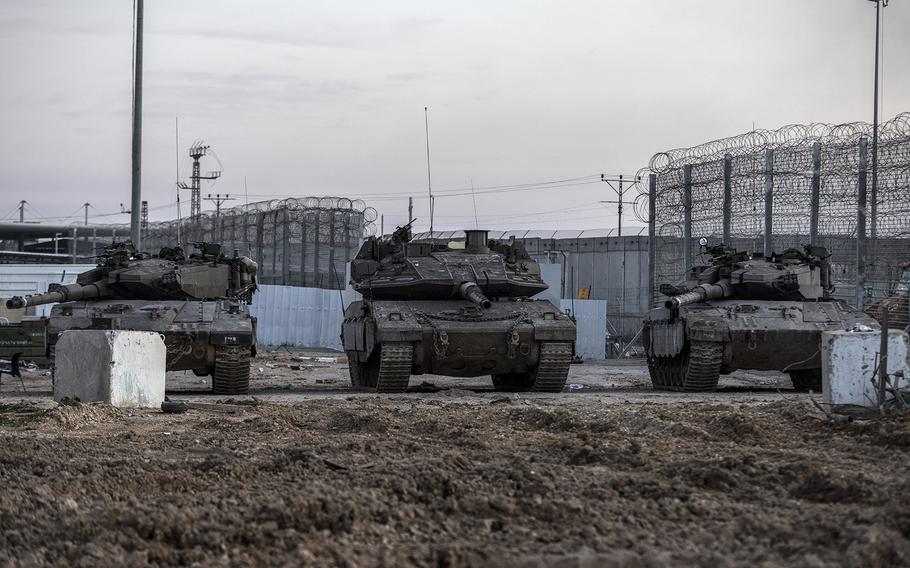
Israeli tanks at the Erez crossing on the Israel-Gaza border on Jan. 20, 2024. (Heidi Levine for The Washington Post)
Facing pressure to get more aid into the Gaza Strip, Israel said this week it is working toward opening the Erez crossing, a major checkpoint between Israel and northern Gaza.
Jamie McGoldrick, U.N. humanitarian coordinator for the occupied Palestinian territory, said in a statement Saturday that Israel “plans to open Erez Crossing temporarily to move much needed food, water and sanitation items, shelter and health materials from Ashdod port” in southern Israel, north of the Erez crossing. But the timing of the reopening remains unclear. McGoldrick said on Friday that Israel had not yet ratified the decision to open the crossing, and that once approved, the checkpoint would not be operational for a few weeks.
The reopening could help move assistance into hunger-stricken northern Gaza, but may face the same challenges seen throughout the war.
Here’s what to know.
Why is the Erez crossing important?
Reopening the Erez crossing on the border between northern Gaza and Israel could provide an entry point for aid into northern Gaza, which has been particularly devastated by the war since Oct. 7. A report last month warned that famine was imminent there. Israel disputed the report’s findings.
Before the war, northern Gaza was the strip’s most populous region. But much of Gaza’s population has now fled south to Rafah, on the border with Egypt. Palestinians been repeatedly forced to evacuate different areas as Israel has expanded its offensive.
Israel has said it intends to see through its military campaign in Gaza by invading Rafah and rooting out Hamas forces there. The United States and others have raised concerns about such an operation, warning that the humanitarian consequences would be severe.
If northern Gaza’s former inhabitants were to return, they would face a flattened landscape with little food, water or shelter. The reopening of the Erez crossing could provide a channel for deliveries of those resources.
What has Erez been used for in the past?
The border crossing, known to Palestinians as the Beit Hanoun crossing, was a key checkpoint between the Gaza Strip and Israel before the war, primarily used for foot traffic rather than the transport of goods or aid. Those typically allowed through included Palestinian patients, workers and a limited number of international and local organization employees, as well as international staff of diplomatic missions and institutions.
To pass through the checkpoint, pedestrians traversed a long, enclosed walkway bracketed by a lattice of metal bars, under strict security. Israel determined which categories of people were permitted to enter and exit through Erez, while Hamas occasionally exercised authority over the entry of certain Palestinians and foreigners.
Commercial goods were generally prohibited from entering via the Erez crossing, except for limited allowances such as imported cars on specific days of the week. Commercial traffic was primarily directed through the Kerem Shalom crossing in the southern Gaza Strip.
What happened to the crossing on Oct. 7th?
Erez was one of 14 places along Gaza’s border with Israel that Hamas militants breached on Oct. 7, according to a Washington Post investigation. Photos taken after the attack showed damage to the facility, with a large section of the covered footpath destroyed.
According to satellite imagery and an on-the-ground report by Al Jazeera, a road at the crossing has been razed, raising questions about how quickly infrastructure could be repaired to facilitate the transit of aid in to Gaza.
Will opening the Erez crossing be enough?
The United States warned Israel Thursday that it needs to do more to get aid into Gaza, vaguely threatening that U.S. aid policy to Israel could change if it does not. The terse words from the United States came after seven aid workers were killed in Gaza by Israeli strikes.
Even if Erez reopens, aid delivery could face the same hurdles seen at the other two points of entry by land into the Gaza Strip - Rafah and Kerem Shalom, both in southern Gaza.
Aid groups and the international community, including the United Nations, have said that onerous checks and arbitrary rules by Israel have slowed and hampered efforts to get aid into Gaza. A small portion of the trucks waiting to deliver aid into Gaza are allowed in. Once they do enter Gaza, they face security issues as Gazan police have been struck by Israel, leading aid groups to hesitate to deliver aid as their safety is not guaranteed.
Secretary of State Antony Blinken said Israel needs to reduce delays at crossings as the United States monitors whether Israel can produce “results” in improving aid deliveries to Gaza.
He said Friday that the United States would be watching the number of aid deliveries entering Gaza “on a sustained basis, and not just getting in but then getting around, and the aid being distributed through Gaza, including critically northern Gaza.”
Loveday Morris, Beatriz Ríos and Victoria Bisset contributed to this report.